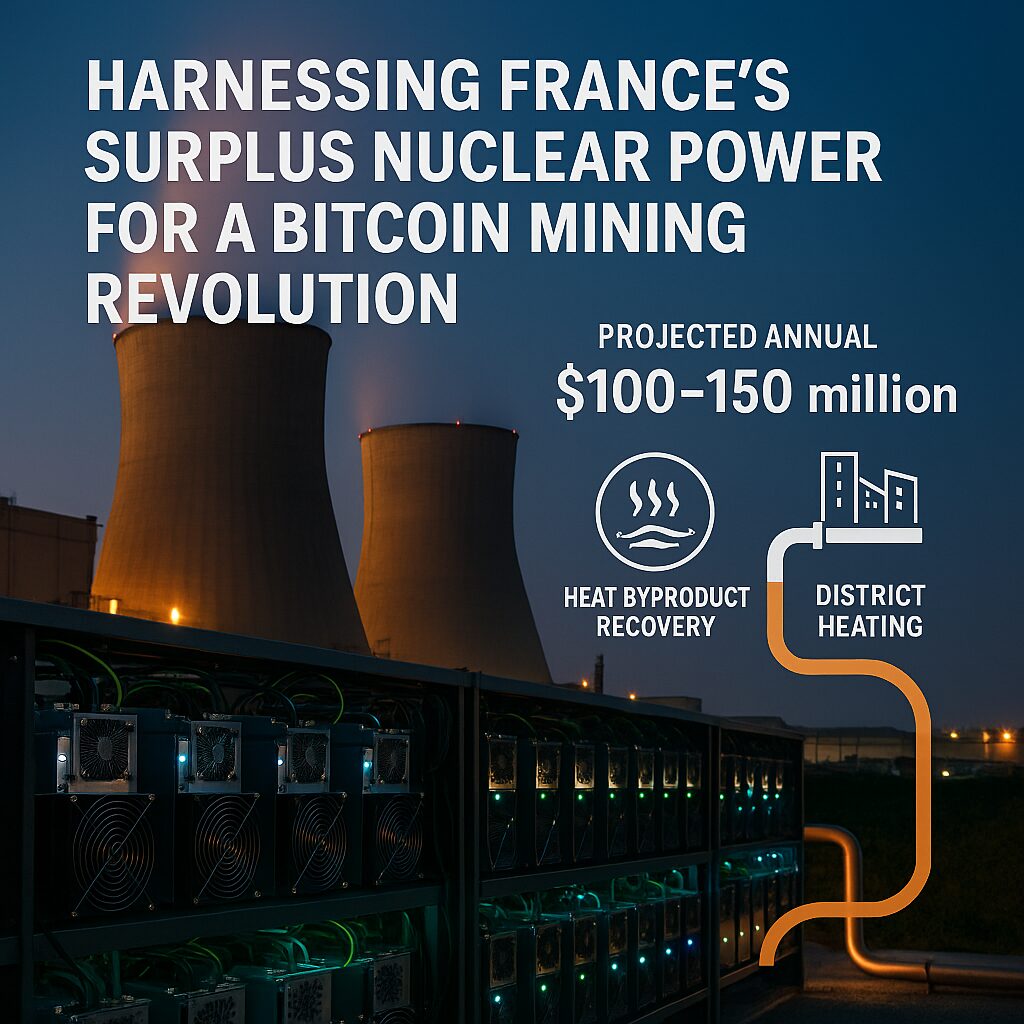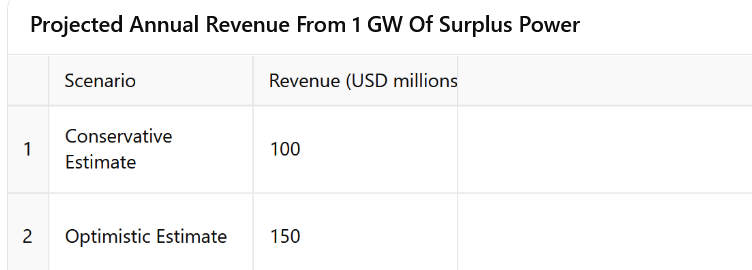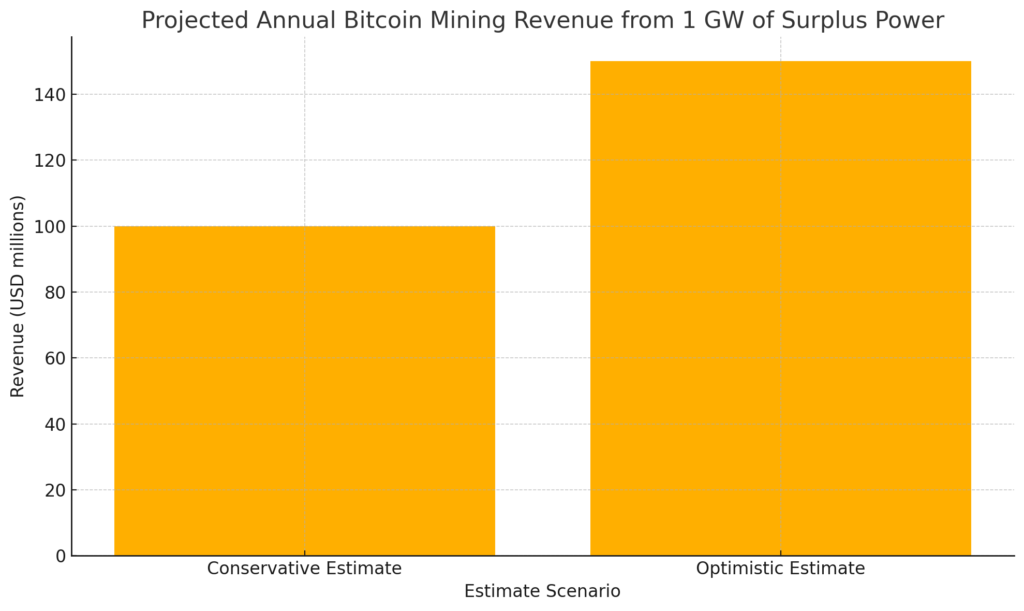
Main Points:
- French National Assembly proposes a five-year pilot to use surplus nuclear and renewable energy for Bitcoin mining, projecting $100 – $150 million in annual revenue.
- Pilot centers co‑located at nuclear sites would operate only during low-demand periods, stabilizing the grid without affecting consumer supply.
- Heat byproduct recovery could supply district heating, greenhouses, and industrial processes, mirroring successful projects in Finland.
- Global trends: from Brazil’s Adecoagro–Tether renewable mining initiative to Deutsche Telekom’s surplus wind/solar mining pilot in Germany, and UN climate tax proposals on energy‑intensive crypto.
- Regulatory clarity: France’s bill complements recent U.S. legislative moves (e.g., the CLARITY and GENIUS Acts) that bolster mining’s legitimacy.
- Challenges include energy price volatility, renewable intermittency, infrastructure retrofits, and policy harmonization.
Proposal Overview and Economic Rationale
On July 11, 2025, legislators in France’s National Assembly introduced a bill to launch a five‑year experimental pilot that redirects electricity otherwise wasted during low-demand periods into Bitcoin mining centers co‑located at nuclear plants.
According to data from the Association for the Development of Digital Assets (ADAN), dedicating just 1 GW of surplus power could generate between $100 million and $150 million annually. This proposal aims not only to monetize unsold electricity—often sold at a loss—but also to turn mining into an asset for grid stability and energy transition.


Projected Annual Revenue
Projected Annual Revenue from 1 GW of Surplus Power
Grid Stabilization without Consumer Impact
The draft law explicitly allows energy producers to “switch on” mining rigs only when demand is low and surplus power would otherwise be curtailed. This demand‑response capability acts as a real‑time buffer, absorbing excess generation and preventing voltage fluctuations in a grid increasingly stressed by intermittent renewables. Importantly, consumer electricity supply remains unaffected since mining operations ramp up solely during off‑peak periods.
Heat Recovery: Turning Waste into Value
Mining equipment emits substantial low‑grade heat. The French bill envisions capturing this heat to supply:
- District heating in nearby communities.
- Greenhouse agriculture, boosting local food production.
- Industrial processes requiring moderate temperatures.
A case study in Finland demonstrates this potential: Marathon Digital’s 2 MW pilot heats an entire town of 11,000 households, with that water‑cooled infrastructure reaching over 70 °C—ideal for district heating systems. Another expansion now warms 80,000 residents, illustrating scalability and community benefits.
Global Trends in Green and Surplus‑Power Mining
- Brazil (Adecoagro & Tether): Exploring agricultural and renewable co‑location to power mining, unlocking value in sugarcane ethanol byproducts.
- Germany (Deutsche Telekom): Launched a surplus renewable pilot leveraging unused wind and solar capacity to run mining operations, showcasing telecom–energy convergence.
- UN Climate Tax Proposal: A task force led by Kenya, Barbados, and France suggests a $0.045/kWh levy on energy‑intensive minting, aiming to redirect up to $5.2 billion annually into sustainability funds.
These examples underscore a broad geopolitical shift: mining is no longer merely a power sink but could become a dynamic tool for energy management and decarbonization.
Regulatory and Legislative Context
France’s initiative follows closely on the heels of U.S. advancements:
- The CLARITY Act clarified the SEC and CFTC’s jurisdiction over digital assets, reinforcing legal certainty for miners and exchanges.
- The GENIUS Act imposes annual audits on stablecoin issuers above $50 billion market cap, indirectly strengthening confidence in crypto infrastructure.
By creating a clear pilot framework, France hopes to position itself as a leader in sustainable crypto infrastructure, attracting investment and innovation to its energy and tech sectors.
Technical and Infrastructure Considerations
- Renewable Intermittency: Wind and solar variability requires miners to adjust power draw in milliseconds, demanding sophisticated control systems.
- Grid Integration: Existing substations and transmission lines may need upgrades to handle bidirectional flows—both consumption (mining) and potential energy fed back from storage.
- Cooling and Heat Exchange: Effective heat recovery hinges on immersion‑cooling or water‑cooling rigs; air‑cooled setups capture only ~50 % of waste heat.
- Energy Market Dynamics: Surplus pricing and merchant tariffs must be negotiated to ensure mining remains profitable without distorting wholesale markets.
Economic and Community Impacts
- Job Creation: Deployment of mining facilities and heat‑recovery plants can spur local employment—from technicians to project managers.
- Rural Revitalization: Co‑location of mines at underutilized nuclear or renewable sites can bring infrastructure and services to remote areas.
- Agricultural Synergies: Heat‑driven greenhouse farming and aquaculture offer new revenue streams for farmers, buffering against commodity price swings.
Risks and Challenges
- Regulatory Shifts: Future climate taxes or carbon pricing could alter cost structures suddenly.
- Technology Adoption: Slow uptake of immersion cooling or virtual power plant integration may limit heat recovery potential.
- Public Perception: Despite green framing, communities may resist mining operations due to historical narratives of energy waste.
- Capital Expenditure: Initial investments in rigs, cooling infrastructure, and grid interties remain substantial, requiring low‑cost financing or subsidies.
Conclusion
France’s proposed pilot marries the nation’s leading nuclear infrastructure with cutting‑edge blockchain applications, crafting a model for sustainable energy valorization. By monetizing surplus electricity, stabilizing the grid, and harnessing waste heat for local communities, this initiative could set a global standard. Parallel pilots in Brazil, Germany, and Finland—along with emerging UN climate tax frameworks—underscore the industry’s rapid pivot toward responsible crypto mining.
As the pilot unfolds over the next five years, policymakers and industry stakeholders will closely watch its technical feasibility, economic viability, and community acceptance. Should it succeed, France may unlock hundreds of millions in new revenue, reduce CO₂ emissions, and fortify its grid against the variability of renewable generation—demonstrating that Bitcoin mining can indeed become a pillar of the future energy economy.

